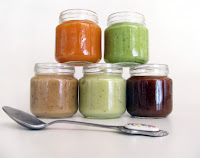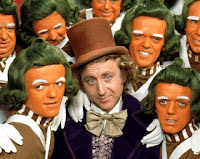In my prior post I mentioned all the reasons why I plan to use cloth diapers. For this post I will stick to the details. All the information is a bit overwhelming, but definitely doable! I was happy to find out that there is also a cloth-diapering store in Bloomington called the Green Nursery. I am going to set up a gift registry there so that the products can be purchased locally.
The book, as well as Michelle, continuously repeated what I am now calling my top 3 tips.
1. Use disposables for the first few weeks. While newborns are super tiny, it's really hard to get a good enough fit with cloth that is going to contain all the newborn poo. The baby’s first bowel movements consist of meconium, a sticky green-black substance present in the intestine before birth. This can stain and even ruin cloth diapers.
2. Sample 3 – 4 different brands and styles of diaper before making a large purchase. Every diaper fits every baby differently, and you don’t want to get stuck with one brand when your baby does better with another. There are trial packs you can use and return for nearly a full refund to determine what works best.
3. Start out with all-in-ones (AIOs) or pocket-style diapers. They are the easiest to use and are most like disposables. As you get more comfortable with the process, you can begin using prefolds and covers.
If you are like me and you read tip #3, you probably thought, what in the world is she talking about? So, now begins the brief explanation of the various types of cloth diapers. I am going to completely omit the discussion on the “old school” flat cloth diapers. They are probably the most economical way to cloth diaper; but it’s not for us. My husband would loose his mind.
- All-in-ones (AIOs): these are the closest diapers to a disposable because they fit the baby like a disposable. The absorbency layer is sewn into the diaper, which can make it more convenient but they also take longer to dry after washing.
- Pocket diapers (pockets): these have 3 layers; an outer waterproof shell, an attached inner liner (typically fleece), and a pocket layer where you stuff it with absorbent inserts. The inserts are removed during washing, which allows you to wash and dry the diaper more efficiently. These come in regular-sized or one-sized diapers. One-sized diapers can be used longer and sized accordingly with snaps or adjustable elastic.
- All-in-two (AI2s)/Hybrids: these diapers are where the cloth and disposable diapers meet. There is a cloth outer shell that is washable and reusable, but the inside is usually flushable or disposable. They are typically the priciest option but are very convenient when cloth isn’t practical. Many hybrid systems accommodate both disposable and reusable lines.
- Prefolds/Fitted and covers: Prefolds are flat sheets of fabric that have thicker layers of fabric sewn into the middle where the baby requires the most absorbency. They are folded and fastened with a pen or simply stuffed inside a diaper cover. Fitted diapers provide a contoured fit because they have elasticized legs and waste and have either Velcro or snap closures. Both of these fit inside a diaper cover, which are used as the outer waterproof layer. Diaper covers come in a variety of fabric options and can fasten with snaps or Velcro.
Per suggestion number 2 on the “top 3 tips,” I plan to initially order the sampler pack to determine which diaper option is best for us. There are also some required accessories that go along with cloth diapering.
- Liners - After they start having solids or are formula fed, the poo needs to be flushed down the toilet. Michelle suggested that I buy a yard of fleece from the local fabric store and cut it into approx 4"x10" strips. Then, place it on top of the prefold or diaper (right next to the baby’s bottom). If baby poos, it makes it much easier to just plop it in the toilet versus scraping it off the diaper itself.
- Wipes – It was recommended that we use cloth wipes instead of disposable (at least at home) because then you don't need a separate place to throw the wipes away. There are several places you can purchase the wipes, but I think I am just going to sew some myself using the same type of fabric as Quilter’s Nappies uses. http://hyenacart.com/QuiltersNappies/index.php?c=31&p=74035 Michelle suggested that I have a squirt bottle next to the wipes filled with water and a little baby soap to squirt it on the wipe and then clean the baby up.
- Wet bags/Pail liners – The book and Michelle both recommended purchasing 2 wet bags for when you're out and about. They should have zippers to keep all the stink and wetness inside. We should also purchase an 11-gallon trash can with a lid that can be lined with washable pail lines. They can be tossed into the washer with the wipes and diapers every 2-3 days.
- Diaper sprayer- it was suggested that the diaper sprayer is one of the best investments a cloth diapering mama can purchase. The sprayer easily attaches to your toilet to enable you to rinse off ultra-poopy diapers over your toilet, not in your washing machine. Michelle also gave me a website with instructions of how to make a sprayer yourself!
With all this information I created my cloth diapering wish list. Though there will definitely be a large initial investment, I will not have to purchase boxes and boxes of disposable diapers that will be around for my baby’s children to worry about!
- 2 week supply of newborn baby diapers
- Cloth diaper trial set
- Cloth diapers (18-24) & diaper covers (6)
- 36 Cloth wipes
- Squirt bottle
- Flushable Liners
- 2 pail liners
- 11 gallon trash can
- 3 wet bags
- Diaper sprayer
- Cloth diaper detergent
- 6 fleece liners
- 6 natural fiber doublers for the nighttime
- Cloth changing pad
- Cloth diaper safe cream
























